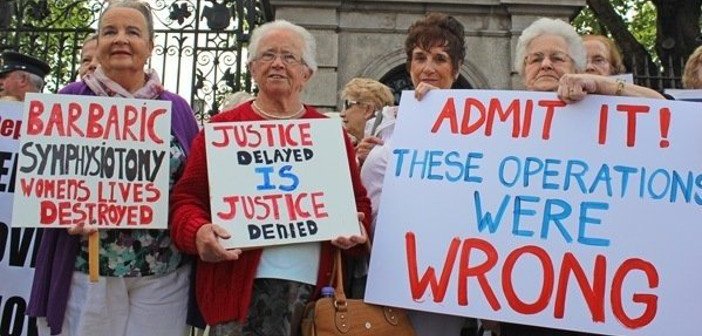Destroying Symphysiotomy Survivors’ Records Would Silence More Irish Women
Between 1944 and 1984 an estimated 1,500 women suffered symphysiotomies during childbirth in Ireland. The procedure, which involves the cutting and unhinging of the pelvis, was performed on women to widen the birth canal during complications – often without their knowledge or consent. In most places, symphysiotomies were replaced by caesarean sections due to technological improvements and a decreased risk of maternal death. Ireland is the only developed country that continued practicing symphysiotomies after the nineteenth century.
It was only years later that the truth regarding these operations became apparent. However, the reports carried out did little to compensate those who suffered, or to hold any institution, group, or individual accountable for these procedures. In 2012, the Walsh report found that although the Catholic Church had “encouraged, if not insisted upon, symphysiotomies,” consent had not been a legal requirement. The following year, the Murphy report suggested that symphysiotomies were a justifiable, necessary medical procedure at the time.

According to Survivors of Symphysiotomy (SOS Ireland), this was not the case. The group, who have been actively seeking restitution for their members for years, maintain that the operations were not a necessity, and that they only occurred due to the personal preference of some doctors.[pullquote] In most places, symphysiotomies were replaced by caesarean sections due to technological improvements. Ireland is the only developed country that continued practicing symphysiotomies after the nineteenth century.[/pullquote]
Unlike with a caesarean section, the number of children a woman can birth after a symphysiotomy is not limited. However, unlike with a caesarean section, the mental and physical effects of a symphysiotomy can last a lifetime.
Many members of the group are long sufferers of chronic pain, physical disability, mental health issues, and incontinence. One survivor, Rosaleen O’Connor, described the procedure as “butchery,” saying that she had no idea what kind of operation she would be undergoing during her second pregnancy when she was just twenty-one years old. In 2014, she talked to the Independent about her experience:
It’s a thing you’ll never forget the rest of your life (…) What they did to me was they ruined my life (…) I’m lucky actually because my baby was alive, but God help other women who went through all that and their baby died. That must have been very hard for them.
O’Connor also stated that despite the reviews and reports the state had been planning to carry out at the time, she believed that they were simply waiting for the survivors to die.
[iframe id=”https://www.youtube.com/embed/FC6C2_9b-JY” align=”center” mode=”normal” autoplay=”no” maxwidth=”750″]
This past month has seen a resurgence in support for SOS’s campaign for justice for these women. Following the introduction of the symphysiotomy payment scheme, survivors were asked to submit their medical documents should they wish to request compensation. The scheme then posted a notice on their website informing all applicants that they had until March 20th to request the return of their records. If applicants did not want their documents returned to them, or if they failed to make contact, all documentation would be shredded.
Although the Department of Health insists that this process aligns with the legal requirements necessary in obtaining such records, Dr Vicky Conway recently disputed this claim in the Journal, stating that the scheme is required to get rid of the documents, not destroy them. Not only has the state been unwilling to hold any agency accountable for symphysiotomies, but it would now seem that their intention is to erase the evidence entirely.

Survivors of Symphysiotomy and human rights advocates all across the country have condemned the scheme’s decision, citing it as yet another mass silencing of Irish women and the abuses they have suffered. In 2014, the United Nations Committee Against Torture requested that the government fully compensate those affected, while also prosecuting the gynaecologists and obstetricians and who performed symphysiotomies without consent. The committee declared the practice inhumane, and while those still living can claim for compensation, nobody has ever been held accountable for their decision to carry out the procedure rather than a caesarean section.[pullquote]Survivors of Symphysiotomy and human rights advocates all across the country have condemned the scheme’s decision, citing it as yet another mass silencing of Irish women and the abuses they have suffered.[/pullquote]
Survivors of Symphysiotomy are calling on the government to intervene in the destruction of their survivors’ documents. These records don’t just prove that symphysiotomies were carried out, but they provide first hand evidence of the doctors involved, the medical reports filed, and the suffering that these women underwent after the operation. SOS aim to expose the truth behind these unnecessary procedures, and ensure that the voices of their victims are not suppressed any longer.
You can sign SOS’s petition to halt the shredding of symphysiotomy records here.
Join their campaign here.
